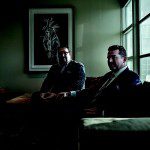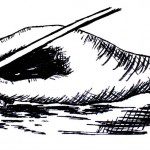Elements of Style
“You’re going to court,” my editor told me on my second day as a National Post intern. “You need to leave now.” I was all nerves as I threw my recorder and notebook into my shiny, black purse and sprinted to the elevator. I was off to the sentencing of wannabe Toronto rap star and convicted killer Mark Moore. Christie Blatchford had been covering the case, but she was out of town on assignment, and I was the undeserving—but lucky—available person. As the elevator slowly dropped to ground level, I became consumed with anxiety knowing that Blatchford would likely read the piece. I scanned my outfit: a pleated, cream-coloured sleeveless blouse, a pair of fitted, cropped black pants and two-toned, leather-heeled sandals. Despite my panic, I felt confident about my choices; I looked put together. I’d spent the previous night picking out an outfit to convey that I took my stint at the Post seriously. My degree in fashion helped me realize that my personal style allows me to assert poise. Dressing well is as important as showing up to work on time. As the elevator doors opened, I took a deep breath. “As long as you look like you know what you’re doing,” I told myself, “people will think you do.”
The next day, senior writer Peter Kuitenbrouwer visited me at my desk. He was holding the paper, opened to my court story on A3—my first byline for the Post. “Nice work,” he said. “But I think you meant to write ‘peace’ instead of ‘piece.’” My confidence sank, but I adjusted my handcrafted necklace—a reflex I assumed was the female equivalent of straightening a tie—and thanked him.
The ability to convey confidence through clothing is something freelance writer Rea McNamara knows a thing or two about. During times of uncertainty, the former style columnist “glamouflages.” One time, when she felt particularly challenged, she wore red lipstick every day for a week. “I just needed to feel confident,” she says. “And if I didn’t feel confident on the inside, I needed to project that I had my shit together.”
I, too, like to glamouflage. Dressing up gives me an instant boost and makes me feel like I have control—even if I don’t. The way you present yourself sends the outside world a message. “Your sense of style,” says McNamara, “should be reflective of the life you lead.”
We construct identities as we select pieces of clothing. “When you make these conscious decisions about your own personal aesthetics, it feels like you have a sharper take on the world around you,” says Shawn Micallef, co-owner of Spacing and a dapper dresser known for his bow ties. He understands the powerful relationship between clothing and confidence and gets a kick when he leaves the house dressed up. Yet, when working at home, the stylish journalist dresses “terribly.” Unlike Gay Talese, who worked from home dressed to the nines, Micallef doesn’t need a uniform to be productive.
Talese’s style became part of his identity as a journalist. In Rachel Tashjian’s 2015 Vanity Fair article, Talese credits getting his first job at The New York Times to the three-piece suit he wore to the interview. “I was polite, well-dressed,” he said. “I just know, though I never got any confirmation, that I made a good impression.” Tashjian also notes how Talese’s obsession with clothing intertwines with his writing. “When I write stories, it’s like making a suit: the pieces hang together, and you sketch,” Talese said. “The whole process: handwork.”
An effortlessly cool persona makes Joan Didion a style icon in and out of literary circles. French fashion house Céline made her the face of its spring 2015 campaign. “Didion might be the ultimate Céline woman: brilliant, creative, vaguely recalcitrant,” Vogue wrote. She kept a detailed packing list—which included two skirts, cigarettes, a mohair throw and a typewriter—taped inside her closet. “The list enabled me to pack, without thinking, for any piece I was likely to do,” Didion wrote. “Notice the deliberate anonymity of costume: in a skirt, a leotard, and stockings, I could pass on either side of the culture.”
While some writers want to blend in, others stand out. Tom Wolfe’s uniform—his legendary white suit—became synonymous with his work. “Wherever he went, he was the outsider,” Micallef says. “Everyone knew he was the writer.”
During my last week at the Post, I wore gold-stained leather clogs I bought at a flea market after bargaining with a vendor for 20 minutes. Each time I slipped into them and reflected on the victorious price adjustment, they gave me confidence. As the heavy carved heel of the wooden soles hit the newsroom tile, I passed Kuitenbrouwer. “Nice shoes!” he said. I smiled, satisfied that he’d complimented my writing—and my footwear.
Laura Hensley is the departments editor for the spring 2016 issue of the Ryerson Review of Journalism.












































